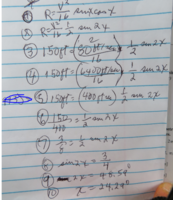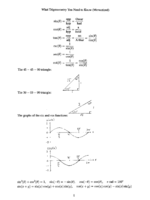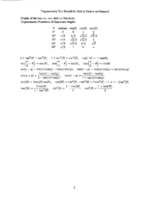allegansveritatem
Full Member
- Joined
- Jan 10, 2018
- Messages
- 962
really? How is that? I will have to think about this...is their some identity such that sinxcox=1/2 sin2x? Wow! I didn't know that....which is no big thing becasue I don't know a lot of things...well I will check this out and post back later. ThanksI don't think you have one variable too many. You may feel you have
one function too many. I know you are dealing with theta for the angles
in the problem.
Aside from that, sin(x)cos(x) = (1/2)sin(2x).
Your line 5 could be: 3/8 = (1/2)sin(2x)
Yes, look up the double angle identities.really? How is that? I will have to think about this...is their some identity such that sinxcox=1/2 sin2x? Wow! I didn't know that....which is no big thing becasue I don't know a lot of things...well I will check this out and post back later. Thanks
I took your advice, after proving to myself that sinxcosx does indeed stand in for 1/2sin2x and here is what I got:I don't think you have one variable too many. You may feel you have
one function too many. I know you are dealing with theta for the angles
in the problem.
Aside from that, sin(x)cos(x) = (1/2)sin(2x).
Your line 5 could be: 3/8 = (1/2)sin(2x)

I can say, and my words would ring with the ring of truth if you could hear them, that I NEVER skip anything. Yes, I have been introduced to double angle identities but there was nothing about 1/2sin2x. Only sin2x, cox2x and tan2x. But Dr. Stokowski seems to me to be one of those teachers who expects his students to put two and two together for themselves. Most of what I learn from his book I learn from doing the exercises at the end of sections and chapters and from the solutions manual. He probably threw that problem in with the expectation that if one knows that Sin2x = 2sinxcosx that one could hit on the fact that sinxcosx = 1/2 sin2x. Ain't always so, I'm afraid.Yes, look up the double angle identities.
I would expect that this problem would only be given after teaching them, as that is the most natural way to solve this.
Are you not going through the book sequentially? Does it not have examples like this, showing the method of solution?
There are two different angles whose sine is 0.75. One is 48.59°; what is the other?I took your advice, after proving to myself that sinxcosx does indeed stand in for 1/2sin2x and here is what I got:
View attachment 18596
I had to use a calculator to get the 8,9, and 10. Not sure how else to do it and also not sure why the problem asks us for the angles (plural) when there seems to be only one.
Oh I see. We are looking for sin2x, not sinx! I am not in math mode right now but will post later with a reply. I could look it up on the net but that would be cheating. I will get back to this tonightThere are two different angles whose sine is 0.75. One is 48.59°; what is the other?
That leads to two acute angles that could be x.
Good. I know that through knowledge and understanding of the unit circle is key in this subject. it's like the hub of the wheel of trigonometry. In that analogy the spokes would be those pesky identities in all their numerousness.That is the rule, and it is not just a rule of thumb (that is, an approximation); it's a fact.
If the sine of an angle has a desired value, then its supplement has the same sine, so, as you found, you can just subtract from 180 degrees to get that other angle.
If you think about the unit-circle definition of the sine, it is the y-coordinate of a point on the circle. Two points on the circle have the same y-coordinate; the angles add up to 180 degrees.
I disagree with Dr. Peterson on this. I dislike burdening my mind with lots of memorization.Good. I know that through knowledge and understanding of the unit circle is key in this subject. it's like the hub of the wheel of trigonometry. In that analogy the spokes would be those pesky identities in all their numerousness.

 mathhelpforum.com
mathhelpforum.com

 mathhelpforum.com
mathhelpforum.com
I disagree with Dr. Peterson on this. I dislike burdening my mind with lots of memorization.
I suspect what I misinterpreted was "many identities can be remembered." I recognize now that "can be" does not imply "should be," and I read more into your statement than was there.I can't see the sheet without signing up, but I suspect we don't disagree at all. The sheet I give my students is one page long, and centers on a few pictures that make those easy. Did I say to memorize hundreds of identities? Maybe you took "a lot" differently than I intended it.
I frequently say I prefer to minimize what I memorize. In fact, what I said there wasn't that I've memorized that particular fact, but that I remember it by referring to other facts (namely, the definition). Of course, when I've been using it recently it tends to stick, but it does so the way friends' names stick -- not by having made a burdensome effort to memorize, but by becoming familiar with them. I use the analogy of friends very deliberately.
On the other hand, I find that some people memorize things more easily than I do, and visualize (e.g. the unit circle definitions) less easily than I do. So what works for me may not be what works for them.


I like that!Of course, this, too, is an identity! [MATH]\sin(\pi - \theta) = \sin(\theta)[/MATH] in radians, or [MATH]\sin(360° - \theta) = \sin(\theta)[/MATH] in degrees.
And many identities, like this one, can be remembered directly in terms of the definitions.
Using identities is like having a lot of friends, and knowing them well enough to say, "This is a situation where Fred could help me." The hard part of trig is simply that you have too many friends to keep track of at first! It takes time, and lots of adventures together, to get to know them well enough.
Thanks for this. I will copy it and keep it in a file for reference.I suspect what I misinterpreted was "many identities can be remembered." I recognize now that "can be" does not imply "should be," and I read more into your statement than was there.
I hate to copy someone else's work that is posted at another site, but since the work is on a free site open to all and downloadable from there, it seems like fair use to post it here. If the admins disagree, they can delete it.
View attachment 18661
View attachment 18662
Not my work as I said before.
One more to add:
\(\displaystyle \int sec(x) dx = ln |sec(x) + tan(x)| +C \)
Impossible to derive without "divine intervention".
